Abstract
The growing prevalence of polymer-based plastics in the environment is an imminent risk to the natural world. As an immediate consequence of this, extensive research has been launched over the course of the past few decades in an effort to reduce the damage that manmade plastics cause to the natural environment. The current study attempts to explore the biodegradability of polylactic acid (PLA), a bio-compatible plastic, by incorporating small amount of electron beam irradiated natural fibers (2 to 10%) derived from luffa cylindrica (LC) at varying irradiation doses (0.5 Gy, 1 Gy, and 2 Gy). Natural fiber surface treatment using electron beam irradiation is effective and environmentally friendly. The biodegradation of composites was studied for 90 days in sand, soil, compost, brackish water, fresh water, salt water, and bacterial and fungal conditions. Maximum decomposition was observed in the composite sample (PLA/10% wt of LC fiber at 2.0 Gy) at 15.42% and 4.73% in bacterial and soil environments. X-ray diffraction (XRD) and Raman spectroscopy validated the fiber and PLAs crystallinity and molecular interaction. The derivative thermo-gravimetric curve (DTGA) showed that electron beam irradiation removed moisture, hemicelluloses, and lignin from hydrophilic fibers. The incorporation of LC fibers into the bio-composites resulted in an increase in the glass transition temperature (Tg), melting temperature (Tm), and crystallization temperature (Tc). Additionally, after LC fiber reinforcement, the composites’ dielectric properties were enhanced.
Graphical Abstract













Similar content being viewed by others
Data availability
All data generated or analyzed during this study are included in this published article.
References
Arutchelvi J, Sudhakar M, Arkatkar A, Doble M, BhaduriS UPV (2008) Biodegradation of polyethylene and polypropylene. Ind J Biotechnol 7(1):9–22
Behera AK, Avancha S, Basak RK, Sen R, Adhikari B (2012) Fabrication and characterizations of biodegradable jute reinforced soy based green composites. Carbohydr Polym 88:329–335
Bhatia A, Gupta R, Bhattacharya S, Choi H (2010) Effect of clay on thermal, mechanical, and gas barrier properties of biodegradable poly (Lactic acid) / poly (butylene succinate) (PLA/PBS) nanocomposite. Int Polym Process 25(1):5–14
Bhatnagar S, Kumari R (2013) Bioremediation: a sustainable tool for environmental management—a review. Ann Rev Res Biol 3(4):974–993
Bledzki AK, Gassan J (1999) Composites reinforced with cellulose based fibres. Prog Polym Sci 24:221–274
Byungtae L, Anthony LP, Alfred F, Theodore BB (1991) Biodegradation of degradable plastic polyethylene by Phanerochate and Streptomyces species. Appl Environ Microbiol 57:678
Chabba S, Netravali AN (2005) ‘Green’composites part 1: characterization of flax fabric and glutaraldehyde modified soy protein concentrate composites. J Mater Sci 40:6263–6273
Dalai S, Parida C (2022) Interpretation of Cole–Cole dielectric dispersion of green composites from medical LINAC modified luffa fiber/PLA. J Mater Sci: Mater Electron 33:6911–6925. https://doi.org/10.1007/s10854-022-07871-0
Dalai S, Patra S, Parida C (2022) Study of dielectric properties of electron beam irradiated luffa fiber/PLA composites. Radiat Eff Defects Solids 177(3-4):230–243. https://doi.org/10.1080/10420150.2021.2025056
Dey A, Jali P, Behera AK, Das AB, Pradhan C (2020) A study on efficient microbial biodegradation of cellulose based jute composite. Polym Compos 41:1428–1434
Edwards RC, Kiely KD, Eppley BL (2001) The fate of resorbable poly-L-lactic/polyglycolic acid (LactoSorb) bone fixation devices in orthognathic surgery. J Oral Maxillofac Surg 59:19–25
Ghali L, Msahli S, Zidi M, Sakli F (2009) Effect of pre-treatment of Luffa fibres on the structural properties. Mater Lett 63:61
Gill P, MoghadamTohidi T, Ranjbar B (2010) Differential scanning calorimetry techniques: applications in biology and nanoscience. J Biomol Tech 21(4):167–257
Gollwitzer H, Thomas P, Diehl P, Steinhauser E, Summer B, Barnstorf S, Gerdesmeyer L, Mittelmeier W, Stemberger A (2005) Biomechanical and allergological characteristics of a biodegradable poly (D, L-lactic acid) coating for orthopaedic implants. J Orthop Res 23:802–809
Goutianos S, Peijs T, Nystrom B, Skrifvars M (2006) Development of Flax fibre based textile reinforcements for composite applications. Appl Compos Mater 13:199
Imamura R, Ueno T, Murakami K (1972) Depolymerization of cellulose by electron beam irradiation. Bull Inst Chem Res 50(1):51–63
Ismail H, Mohamad Z, Abu BA (2004) The effect of dynamic vulcanization on properties of rice husk powder filled polystyrene/styrene butadiene rubber blends. Iran Polym J 13:11
Jamshidian M, Tehrany EA, Imran M, Jacquot M, Desobry S (2010) Poly-lactic acid: production, applications, nanocomposites, and release studies. Compr Rev Food Sci Food Saf 9:552–571
Jones R, Matsubayashi Y, TateMiller P, Brambley D (1990) Radiation-Induced cross-linking and chain scission reactions in chlorinated ploymethylstyrene electron-beam resists. J Electrochem Soc 137:2820
Lasprilla AJ, Martinez GA, Lunelli BH, Jardini AL, MacielFilho R (2012) Poly-lactic acid synthesis for application in biomedical devices—a review. Biotechnol Adv 30:321–328
Lodha P, Netravali AN (2005) Characterization of stearic acid modified soy protein isolate resin and ramie fiber reinforced ‘green’composites. Compos Sci Technol 65:1211–1225
Mallick B, Behera R, Panigrahy S, Tiwari TN (2007) Effect of proton irradiation on multiple melting peaks of polyethelene terepthalate. J Mater Sci 42(6):2198–2199
Masmoudi F, Bessadok A, Dammak M, Jaziri M, Ammar E (2016) Biodegradable packaging materials conception based on starch and polylactic acid (PLA) reinforced with cellulose. Environ Sci Pollut Res Int 23:20904–20914
Mazali IO, Alves OL (2005) Morphosynthesis: high fidelity inorganic replica of the fibrous network of loofa sponge (Luffa cylindrica). An Acad Bras Cienc 77:25–31
Mazzanti V, de Luna MS, Pariante R, Mollica F, Filippone G (2020) Natural fiber-induced degradation in PLA-hemp biocomposites in the molten state. Compos Part A: Appl Sci Manuf 137:105990
Mir N, Salavati-Niasari M (2013) Preparation of TiO2 nanoparticles by using tripodal tetraamine ligands as complexing agent via two-step sol–gel method and their application in dye-sensitized solar cells. Mater Res Bull 48(4):1660–1667
Oboh IO, Aluyor EO (2009) Luffa cylindrica-an emerging cash crop. Afr J Agric Res 4:684–688
Ojo OA (2007) Molecular strategies of microbial adaptation to xenobiotics in natural environment. BiotechnolMolBiol Rev 2(1):1–13
Okubo K, Fujii T, Thostenson ET (2009) Multi-scale hybrid biocomposite: processing and mechanical characterization of bamboo fiber reinforced PLA with microfibrillated cellulose. Compos Part A: ApplSciManuf 40:469–475
Panahi A, Monsef R, Dawi EA, Hussein AS, Salavati-Niasari M (2023) Green auto-combustion synthesis and characterization of TmVO4 nanostructures in the presence carbohydrate sugars and their application as visible-light photocatalyst. Solar Energy 258:372–382
Parida S, Jena RC, Samal KC, Chand PK (2012) Isolation and identification of pathogenic bacteria from brackish waters of Chilika Lagoon, Odisha, India for pharmaceutical use. Mal J Microbiol 8:197–202
Parida C, Dash SK, Pradhan C (2014) FTIR and Raman studies of cellulose fibers of Luffa cylindrica. Open J Compos Mater 5(1):5
Parida C, Patra S, Parasar SKS (2017) Study of dielectric properties of biodegradable composites using (Poly) lactic acid and Luffa fiber. AIP Confer Proc 1832(1):040016. https://doi.org/10.1063/1.4980218
Patra S, Mohanta KL, Parida C (2019) Mechanical analysis of bio-composites using gamma irradiated fibers of Luffa cylindrica. In: International Conference on Intelligent Computing and Communication Technologies. Springer, Singapore, pp 253–259
Paul M-A, Delcourt C, Alexandre M, Degée P, Monteverde F, Dubois P (2005) Polylactide/montmorillonite nanocomposites: study of the hydrolytic degradation. Polym Degrad Stab 87(3):535–542
Poletto M, OrnaghiLuiz H, Zattera A (2015) Thermal decomposition of natural fibers: kinetics and degradation mechanics. Reactions and mechanisms in thermal analysis of advanced materials. Laboratory of Polymers, Scrivener Publishing, pp 515–545
Pruzinec J, Kadlecik J, Varga S, Pivovarnicek F (1981) Study of the effect of high-energy radiation on cellulose. Radiochem Radioanal Lett 49:395
Raaman N, Rajitha N, Jayshree A, Jegadeesh R (2012) Biodegradation of plastic by Aspergillus spp. isolated from polythene polluted sites around Chennai. J Acad Indus Res 1:313–316
Rashed HMMA, Islam MA, Rizvi FB (2006) Effects of process parameters on tensile strength of jute fiber reinforced thermoplastic composites. J Nav Archit Mar Eng 3:1–6
Salavati-Niasari M, Davar F (2010) Shape selective hydrothermal synthesis of tin sulfide nanoflowers based on nanosheets in the presence of thioglycolic acid. J Alloys Compounds 492(1-2):570–575
Shen J, Xie YM, Huang X, Zhou S, Ruan D (2012) Mechanical properties of Luffa sponge. J Mech Behav Biomed Mater 15:141
Shen J, Xie YM, Huang X, Zhou S, Ruan D (2013) Behaviour of Luffa sponge material under dynamic loading. Int J Impact Eng 57:17
Singh B, Sharma N (2008) Mechanistic implications of plastic degradation. PolymDegrad Stab 93:561–584
Tripathy S, Jali P, Parida C, Pradhan C (2020) Study on biodegradability and thermal behaviour of composites using poly lactic acid and gamma-irradiated fibres of Luffa cylindrica. Chemosphere 261:127684. https://doi.org/10.1016/j.chemosphere.2020.127684
Tripathy S, Pradhan C, Parida C (2018) Study of biodegradation of Luffa cylindrica/poly (lactic) acid composites. Int J Curr Rev 10:1
Way C, Wu DY, Cram D, Dean K, Palombo E (2013) Processing stability and biodegradation of polylactic acid (PLA) composites reinforced with cotton linters or maple hardwood fibers. J Polym Environ 21:54–70
Yu T, Jiang N, Li Y (2014) Study on short ramie fiber/poly(lactic acid) composites compatibilized by maleic anhydride. Compos Part A: ApplSciManuf 64:139–146
Zenkiewicz M, Richert J (2010) Różański, A Effect of blow moulding ratio on barrier properties of polylactide nanocomposite films. Polym Test 29(2):251–257
Zhong J, Li H, Yu J, Tan T (2011) Effects of natural fiber surface modification on mechanical properties of poly(lactic acid) (PLA)/sweet sorghum fiber composites. PolymPlastTechnolEng 50:1583–1589
Zinatloo-Ajabshir S, Baladi M, Salavati-Niasari M (2021) Enhanced visible-light-driven photocatalytic performance for degradation of organic contaminants using PbWO4 nanostructure fabricated by a new, simple and green sonochemical approach. Ultrason Sonochem 72:105420
Acknowledgements
The authors are indebted to the Department of Botany, Utkal University, Bhubaneswar, India, for providing laboratory support for undertaking the experiments.
Funding
This research was funded by DST, Government of Odishavide Project No. 1184/ST-(BIO)-02/2017.
Author information
Authors and Affiliations
Contributions
Formal analysis, data curation, writing—original draft, and investigation: S.T.; review and editing and data curation: S.P.; writing, review and editing, conceptualization, methodology, and data curation: C.P.; methodology, conceptualization, data curation, project administration, and supervision: C.P. All authors commented on previous versions of the manuscript. All authors read and approved the final manuscript.
Corresponding author
Ethics declarations
Ethical approval
This is not applicable.
Consent to participate
This is not applicable.
Consent for publication
This is not applicable.
Conflict of interest
The authors declare no competing interests.
Additional information
Responsible Editor: George Z. Kyzas
Publisher’s note
Springer Nature remains neutral with regard to jurisdictional claims in published maps and institutional affiliations.
Highlights
• Electron beam irradiation is a very effective and ecologically benign method of treating the surface of natural fibres.
• Composites of poly lactic acid (PLA) and luffa cylindrica(LC) fibres with varying irradiation doses (0.5Gy, 1Gy, and 2Gy) are studied for their biodegradability.
• Most degradation occurred in the composite sample (PLA/10% wt of LC fibre at 2.0Gy), with rates of 15.42% and 4.73% in bacterial and soil environments, respectively.
• Thus the present work aspires to contribute to the goal of creating next-generation electronic gadgets in a sustainable way.
Rights and permissions
Springer Nature or its licensor (e.g. a society or other partner) holds exclusive rights to this article under a publishing agreement with the author(s) or other rightsholder(s); author self-archiving of the accepted manuscript version of this article is solely governed by the terms of such publishing agreement and applicable law.
About this article
Cite this article
Tripathy, S., Patra, S., Parida, C. et al. Green biodegradable dielectric material made from PLA and electron beam irradiated luffa cylindrica fiber: devices for a sustainable future. Environ Sci Pollut Res 30, 114078–114094 (2023). https://doi.org/10.1007/s11356-023-30477-w
Received:
Accepted:
Published:
Issue Date:
DOI: https://doi.org/10.1007/s11356-023-30477-w




